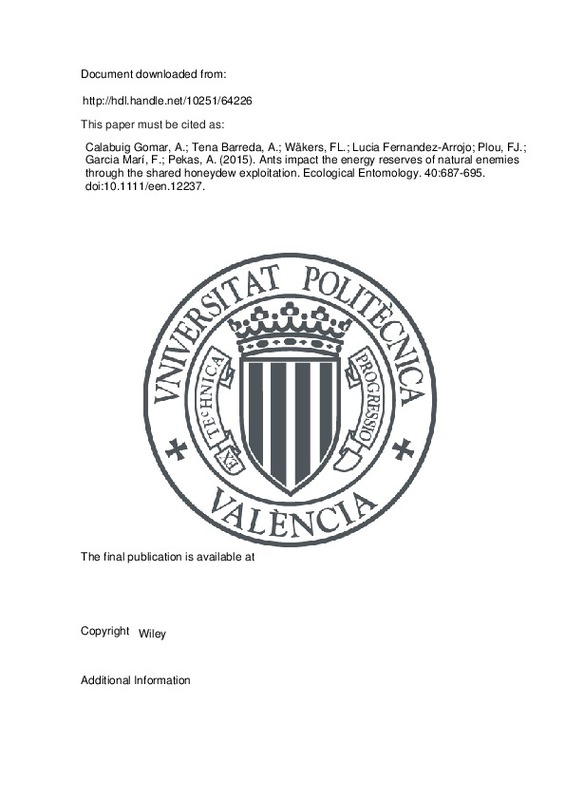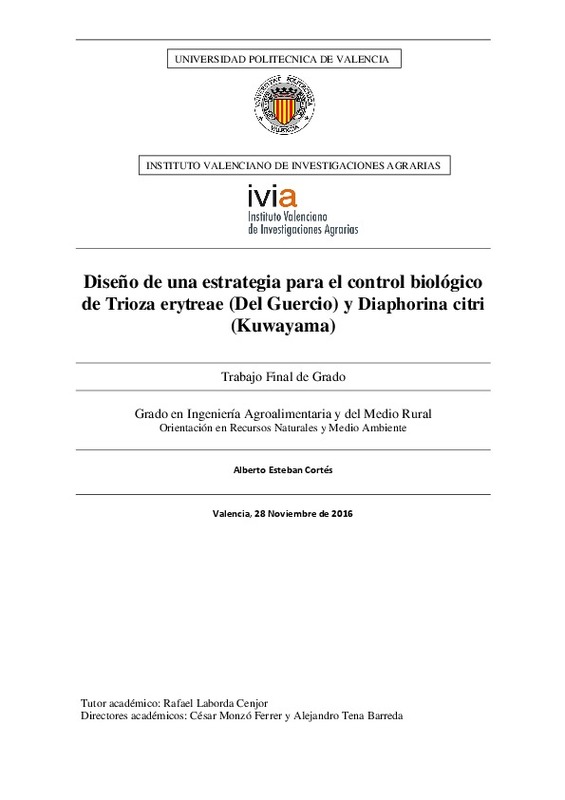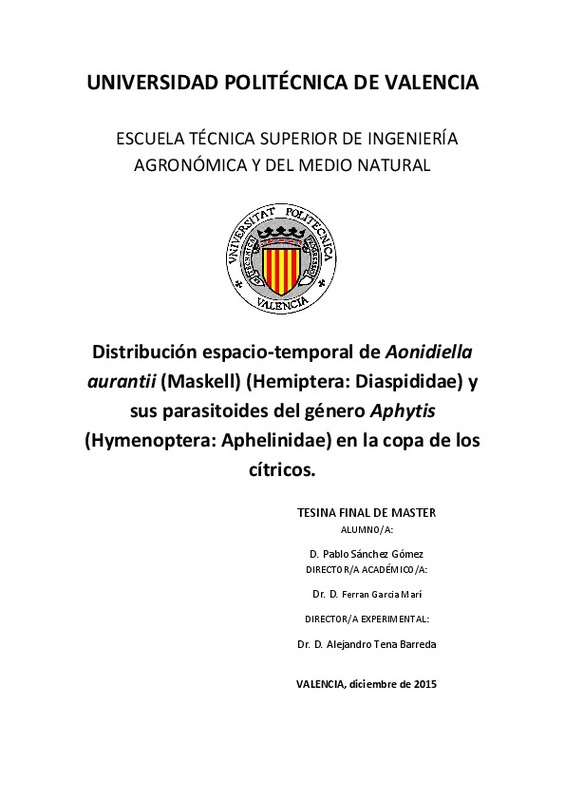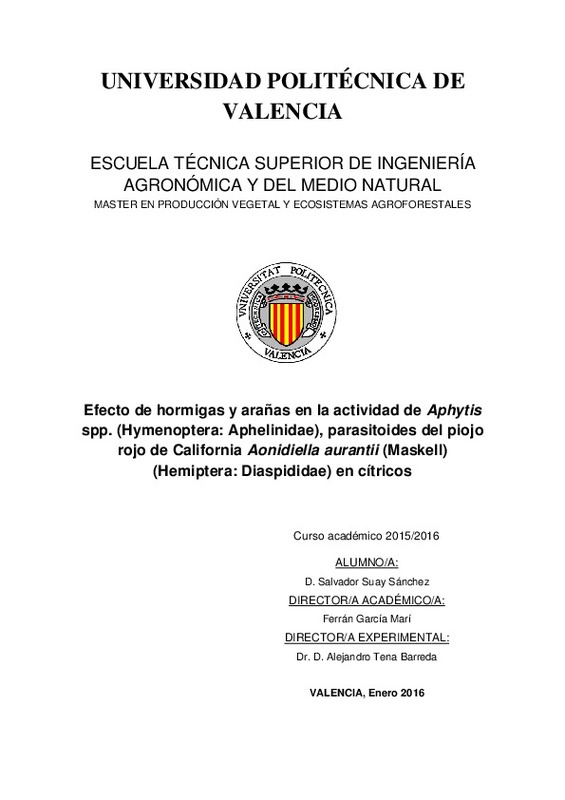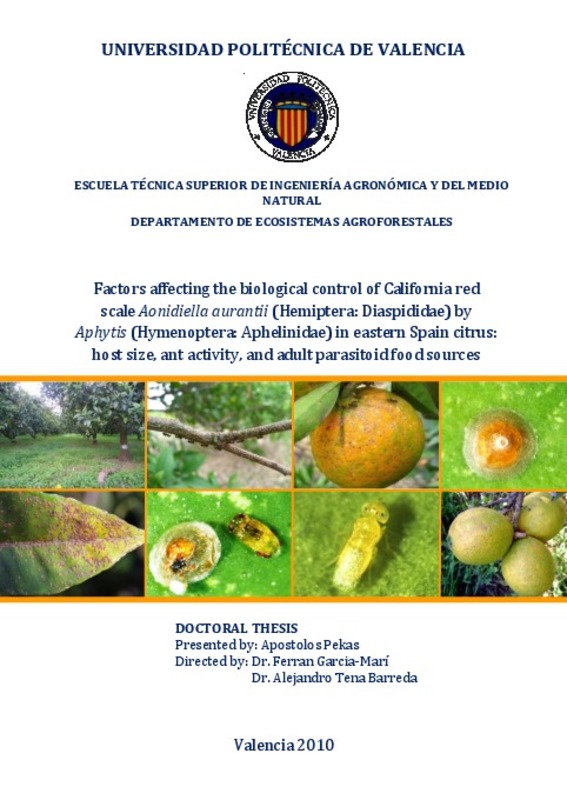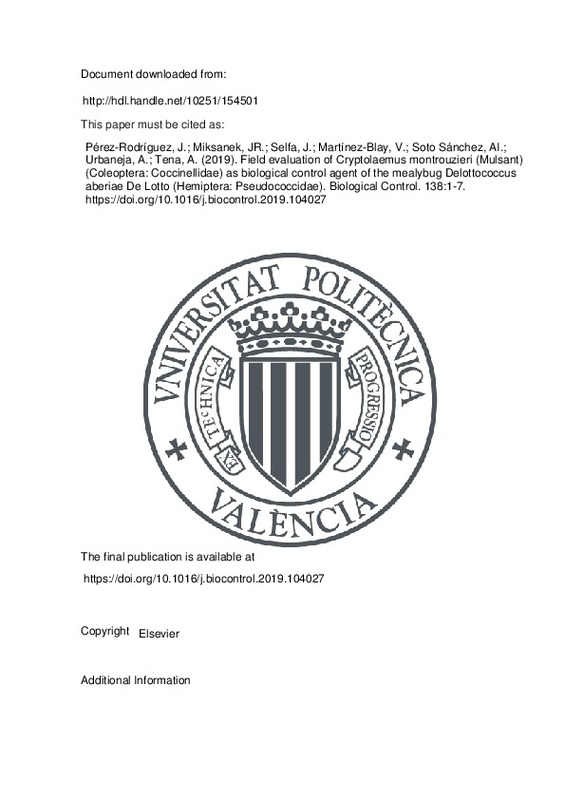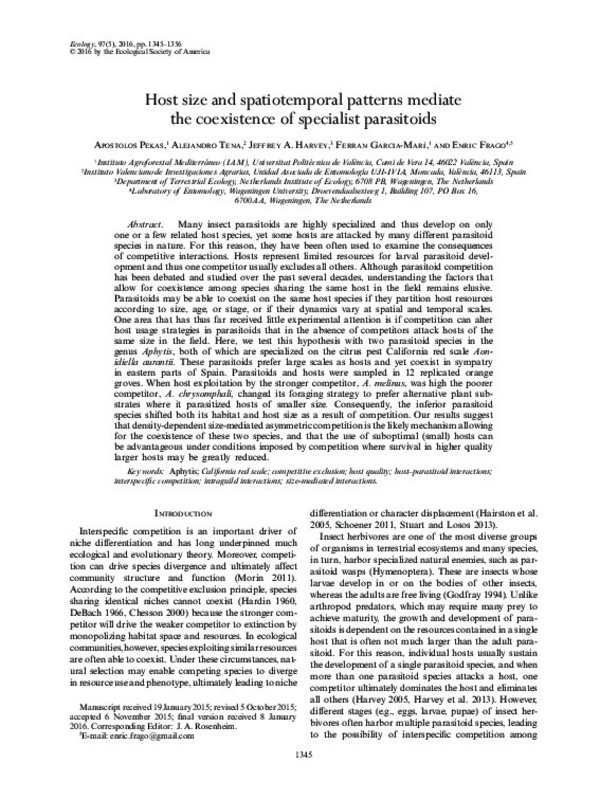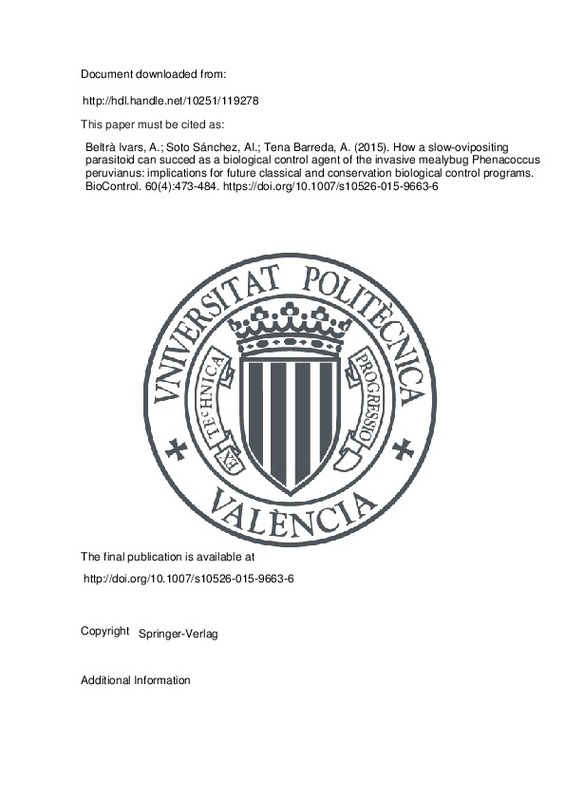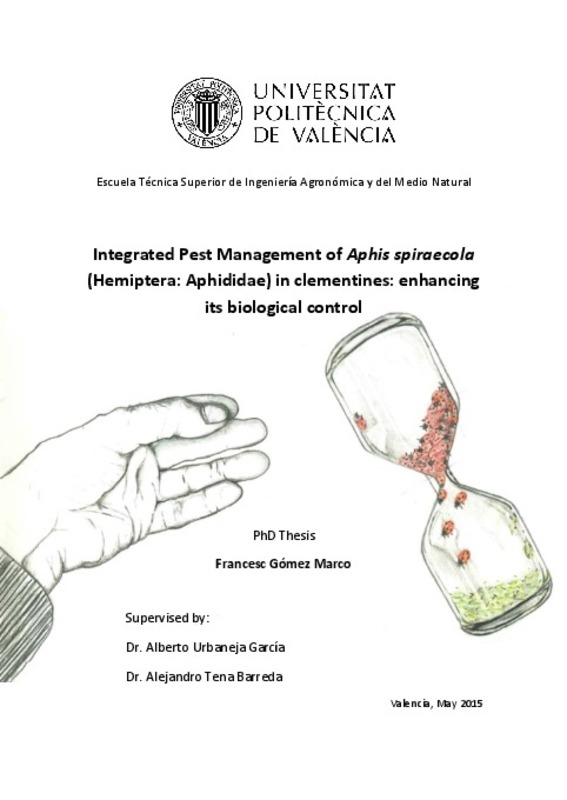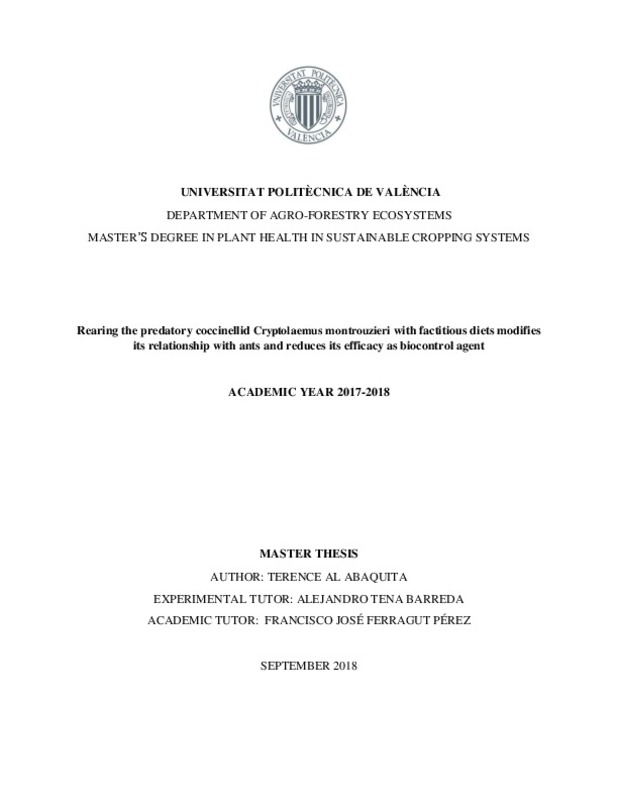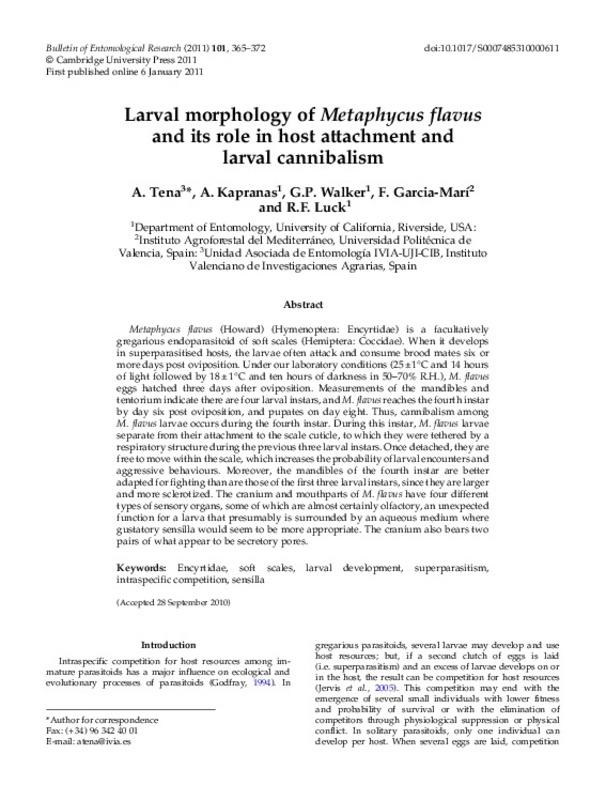

Listar por autor "Tena Barreda, Alejandro"
RiuNet: Repositorio Institucional de la Universidad Politécnica de Valencia
- RiuNet repositorio UPV
- :
- Listar por autor
JavaScript is disabled for your browser. Some features of this site may not work without it.
Buscar en RiuNet
Listar
Mi cuenta
Ayuda RiuNet
Admin. UPV
Listar por autor "Tena Barreda, Alejandro"
Mostrando ítems 1-20 de 27
-
Calabuig Gomar, Altea; Tena Barreda, Alejandro; Wäkers, Felix L.; Lucia Fernandez-Arrojo; Plou, Francisco J.; García Mari, Ferran; Pekas, Apostolos (Wiley, 2015-12)[EN] Ants, as well as many species of parasitoids and predators, rely on sugar-richfoodssuchashoneydewtofulfilltheirenergeticneeds.Thus,antsandnatural enemies may interact through the shared honeydew exploitation. ...
-
Planes Insa, Laura (Universitat Politècnica de València, 2016-08-10)[EN] Pezothrips kellyanus (Bagnall) (Thysanoptera: Thripidae) is a new citrus pest in the Mediterranean basin. Nymphs of P. kellyanus refuge and feed on the surface of young fruitlets. This feeding habit causes rings of ...
-
Qazi, Hareem (Universitat Politècnica de València, 2020-10-23)[ES] Chaetanophothrips orchidii es una nueva plaga invasora de los cítricos en España. Este trips produce daños severos en frutos y, al ser una especie invasora, existe poca información de su biología y control. Recientemente, ...
-
Esteban Cortés, Alberto (Universitat Politècnica de València, 2017-01-10)[ES] El marco del presente trabajo se sitúa dentro de un programa de control biológico de los psílidos Tryoza erytreae (Del Guercio, 1918) (Hemiptera: Psyllidae) y Diaphorina citri (Kuwayama, 1908) (Hemiptera: Liviidae) ...
-
Sánchez Gómez, Pablo (Universitat Politècnica de València, 2017-01-09)[EN] The California red scale, Aonidiella aurantii (Maskell) (Hemiptera: Diaspididae), is one of the most important citrus pest worldwide. Aphytis parasitoids are its main natural enemies. However, in the Mediterranean ...
-
Suay Sanchez, Salvador (Universitat Politècnica de València, 2017-01-09)[EN] Aonidiella aurantii (Maskell) (Hemiptera: Diaspididae) is one of the most important citrus pest in the Mediterranean area. Parasitoids of genus Aphytis (Hymenoptera: Aphelinidae) are its main natural enemies and ...
-
Peris Costa, Paula (Universitat Politècnica de València, 2022-10-19)[ES] El cotonet o cochinilla algodonosa de los cítricos Planococcus citri (Risso) (Hemiptera: Pseudococcidae) es una de las plagas más importantes de los cítricos, de cultivos hortícolas en invernadero y plantas ornamentales ...
-
Pekas, Apostolos; Tena Barreda, Alejandro; Aguilar Martí, Mª Amparo; García Mari, Ferran (Oxford University Press, 2010)[EN] We conducted an ant-exclusion experiment in a citrus orchard to evaluate the overall impact of three ant species native in the Mediterranean, Pheidole pallidula (Nylander), Plagiolepis schmitzii Forel, and Lasius ...
-
Beltrà Ivars, Aleixandre; Pekas, Apostolos; Soto Sánchez, Antonia Isabel; Tena Barreda, Alejandro (Elsevier, 2014-11)[EN] Models based on sex allocation theory predict that when the fitness gains from larger size differ between male and female offspring, mothers should produce the sex that will offer the greatest investment return. ...
-
Plata Sánchez, Ángel (Universitat Politècnica de València, 2024-10-10)[ES] Los pseudocóccidos (Hemiptera: Pseudococcidae), comúnmente conocidos como cochinillas harinosas, son insectos hemípteros chupadores de savia que se alimentan del floema de las plantas. Estos insectos están entre las ...
-
Pekas, Apostolos (Universitat Politècnica de València, 2011-03-14)California red scale (CRS), Aonidiella aurantii (Maskell) (Hemiptera: Diaspididae), one of the most important pests of citrus worldwide, began to cause damages in eastern Spain in 1986. The main biological control agents ...
-
Pérez-Rodríguez, J.; Miksanek, J. R.; Selfa, J.; Martínez-Blay, Victoria; Soto Sánchez, Antonia Isabel; Urbaneja, A.; Tena, A. (Elsevier, 2019-11)[EN] Delottococcus aberiae De Lotto (Hemiptera: Pseudococcidae) is one of the latest invasive mealybugs in Europe. It causes severe fruit distortion and reduced fruit size leading into important economic losses in citrus. ...
-
Beltrà Ivars, Aleixandre; Tena Barreda, Alejandro; Soto Sánchez, Antonia Isabel (Springer Verlag (Germany), 2013-06)Phenacoccus peruvianus Granara de Willink (Hemiptera: Pseudococcidae) is a Neotropical invasive mealybug that has rapidly spread throughout Mediterranean Basin. It has established itself as the principal pest of several ...
-
Pekas, Apostolos; Tena Barreda, Alejandro; Harvey, J.A.; Garcia Marí, Ferran; Frago, Enric (Ecological Society of America, 2016-05)[EN] Many insect parasitoids are highly specialized and thus develop on only one or a few related host species, yet some hosts are attacked by many different parasitoid species in nature. For this reason, they have been ...
-
Beltrà Ivars, Aleixandre; Soto Sánchez, Antonia Isabel; Tena Barreda, Alejandro (Springer-Verlag, 2015)[EN] Phenaccocus peruvianus Granara de Willink (Hemiptera: pseudococcidae) is an invasive mealybug that has become a pest of ornamental plants in Europe and has recently been detected in California, USA. In this work, we ...
-
Pekas, Apostolos; Aguilar Martí, Mª Amparo; Tena Barreda, Alejandro; García Mari, Ferran (Elsevier, 2010-11)The ectoparasitoids Aphytis chrysomphali Mercet and A. melinus DeBach (Hymenoptera: Aphelinidae) are the principal natural enemies of California red scale (CRS) Aonidiella aurantii (Maskell) (Hemiptera: Dias-pididae) in ...
-
Gómez Marco, Francesc (Universitat Politècnica de València, 2015-07-27)[EN] Aphis spiraecola Patch. (Hemiptera: Aphididae) is a key pest of clementines. Biological control of A. spiraecola is still poorly known and efforts were based on the use and conservation of parasitoids but it did not ...
-
Abaquita Lipondog, Terence Al (Universitat Politècnica de València, 2018-11-07)La presencia de hormigas que se alimentan de la melaza que excretan los hemípteros dificulta el control biológico de los pseudocóccidos mediante el uso del depredador especialista Cryptolaemus montrouzieri (Mulsant). Este ...
-
Tena Barreda, Alejandro; Kapranas, A; Walker, G.P.; García Mari, Ferran; Luck, R.F. (Cambridge University Press, 2011)Metaphycus flavus (Howard) (Hymenoptera: Encyrtidae) is a facultatively gregarious endoparasitoid of soft scales (Hemiptera: Coccidae). When it develops in superparasitised hosts, the larvae often attack and consume brood ...
-
Tena Barreda, Alejandro; Beltrà Ivars, Aleixandre; Soto Sánchez, Antonia Isabel (Elsevier, 2012)Protopulvinaria pyriformis (Cockerell) (Hemiptera: Coccidae), a scale native to South America, is a major pest of laurel, Laurus nobilis L., and a potential pest of other ornamental plants in urban green areas. We evaluated ...
Mostrando ítems 1-20 de 27

Universitat Politècnica de València. Unidad de Documentación Científica de la Biblioteca (+34) 96 387 70 85 · RiuNet@bib.upv.es


